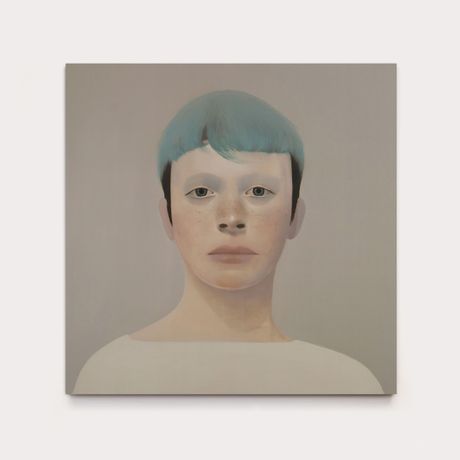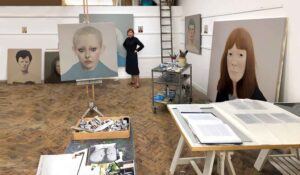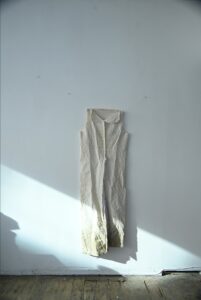
 ‘Themself’, new portrait paintings by Sarah Ball, at Anima Mundi, St Ives, 26 July – 6 Sept 2019
‘Themself’, new portrait paintings by Sarah Ball, at Anima Mundi, St Ives, 26 July – 6 Sept 2019
Entering the gallery and confronted immediately by the arresting portrait of ‘Izzy’, I was half-prepared for a dazzling exhibition of beautifully-painted portraits, accompanied by intriguing back stories. Sarah Ball’s practice relies on gathering found images from the media and from historical archives, and in this new series of works she has roamed through social media, sourcing her muses to explore alternative identities and generate fictional narratives.
Her small portraits are exquisite icons; the detailed attention to hair and clothing allows her to play with ideas around gender and sexuality, at the same time encouraging a reading of the ‘sitter’ as vulnerable. A reading that seems to be confirmed by the large portraits. Take ‘Marie’, for example, a luminous blue-eyed face looking out from a Rembrandtian field of brown – or ‘Marie’, resilient, almost confrontational – brown-eyed in two portraits, blue-eyed in another. Perhaps not so vulnerable then: the empathy that I had prepared to feel on first entering the gallery was beginning to fade. And I was beginning to be bothered by the mask-like quality of the faces: the absence of lines, pores, spots, wrinkles, pointed to an abstraction not only aesthetic but pragmatic.
Perhaps the most instantly-accessible portrait is that of Elliot (top floor) with his/her eyes concealed by large blue-lensed sunglasses, and a blue jacket painted with a flatness reminiscent of Alex Katz’s portraits of white upper-middleclass Americans. Opposite are three small portraits of Elliot in headscarf and oversize spectacles. Between them, the large portrait of ‘Tex’ stares uncompromisingly, blankly, from a field of warm browns, reds and golds.
Far from evincing a feeling of empathy with the imagined lives of these imagined sitters, these images are haunted by the digital media from which they originated. They are full of contradictions and ambiguities, but this is their attraction: underlying this are the cold algorithms of social media that generate images without content, images with fictional narratives, self-promotional images, images of a generation of digital natives seemingly entirely self-absorbed and uncritical of the media that circulate and proliferate their likenesses endlessly.
‘Themself’ is a virtuoso performance of painting that opens up not only questions of image, identity, and gender, but also points to a post-human aesthetic, reflecting us back to ourselves through a miasma of social media practices.
Patricia Wilson Smith
volume 34 no 1 September – October 2019 p 26


Hello Patricia,
Just as the images you wrote about were “full of contradictions and ambiguities, but this is their attraction”, so in our society today which is full of contradictions and ambiguities. Frankly, I am fed up with not being able to call a she a she and a he a he, but have to go about delicately like walking on eggs for fear of offending, or worse, losing my job because I might possibly mix up a he with a she and an ex-she with a he and vs. I find it all so pathetic. However, your review was well written, so please don’t take offense from my comment in this world of undefined sexes.
The social ground is moving. Norms are becoming none norms.
Can you please explain how “norms are becoming none norms”? Perhaps this is the only media source where I can say, I don’t believe it; I’m not convinced. I am a male, was born a male and intend to remain a male. Why can’t our genders be defined and instead of having to remain fluid? I am for the equality of the sexes, but you are born either male or female with some rare occasions born hermaphrodite. I don’t think we can all be hermaphrodites, or is this what we are being asked to become?
Norms change, like fashion. What is accepted at one time may not be in a succeeding time? Prejudice was apparent regarding homosexuality, being an active gay was against the law in my lifetime. No longer. This could reverse goodness knows what with the next step in human history.
Thank you Corey – I’m glad that you appreciated the review. Patricia
Can we talk about something other than gender issues?
Does anyone mind spending £20 to see 1 painting – Leonardo da Vinci’s “Virgin of the Rocks”? Is it an exhibition of da Vinci’s painting or an exhibition of Dr Gabriele Finaldi, the Curator? Maybe he should start thinking of changing his job role from curator to artist, no?
See: https://www.theguardian.com/artanddesign/2019/nov/07/gaze-dont-glance-leonardo-da-vinci-the-mediative-show-opens-at-national-gallery
Ben,
In today’s milieu gender issues are ever-present, even more so in our highly ambiguous art world.
I agree with you that £20 to see one painting, staged by the curator as a circus show is a bit much, but for the rest, that’s about the price of a ticket to the circus today, so what more can one want than to be entertained while viewing a painting from the past, lest we get bored with history?
Vive le cirque!
Fianldi, or rather, please note – Dr. Gabriele Finaldi, has done his utmost to do a piece of performance art around a painting that needed nothing more than an uncluttered wall and proper lighting. He has belittled this work of art with this fanfare and need to entertain and embellish, above all.